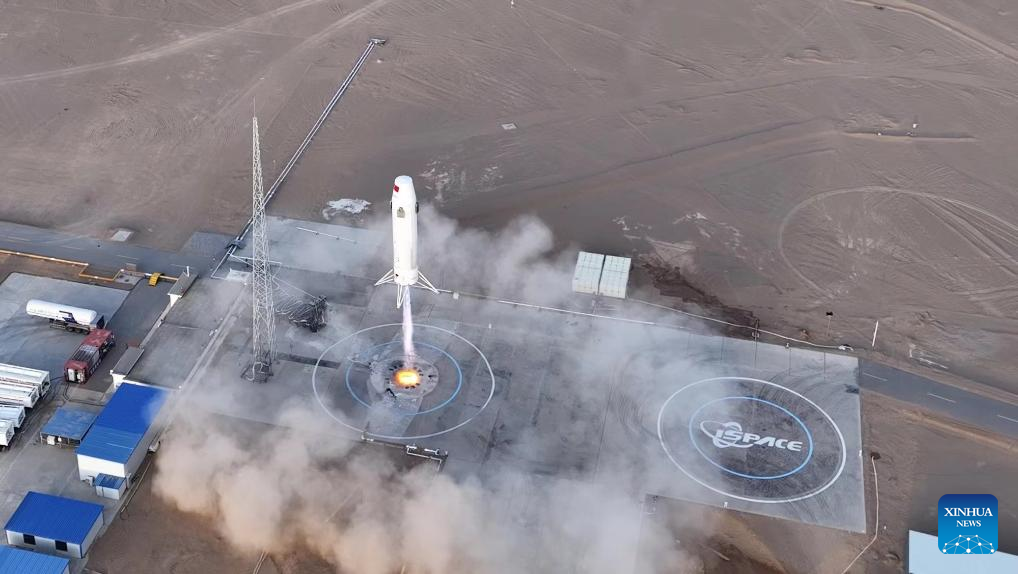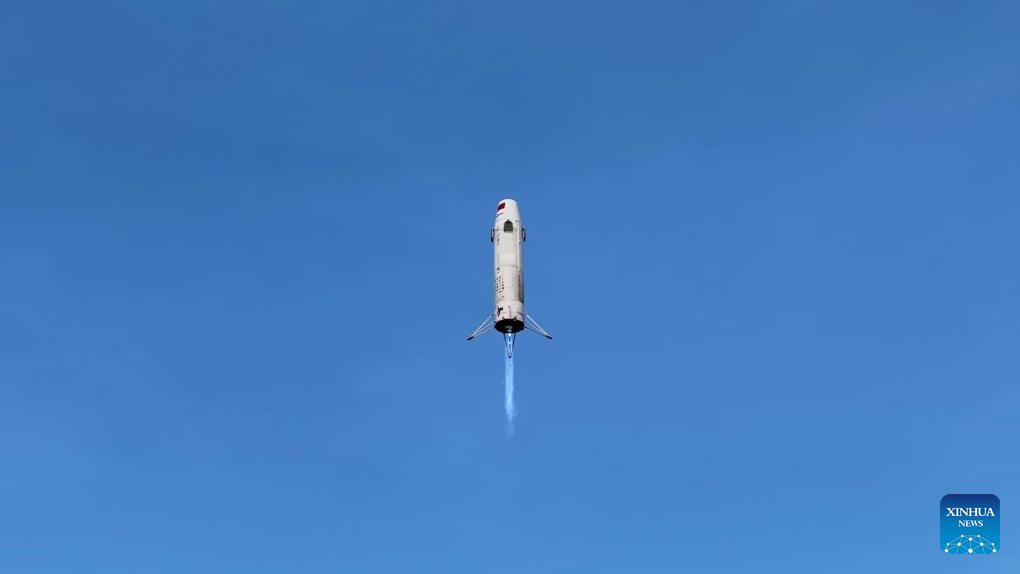
This aerial photo taken on Dec. 10, 2023 shows a Chinese commercial reusable rocket named SQX-2Y blasting off from the Jiuquan Satellite Launch Center in northwest China during its second flight test mission. (iSpace/Handout via Xinhua)
BEIJING, Dec. 14 (Xinhua) -- The Long March family of Chinese launch vehicles marked a 500th spaceflight on Sunday by launching a Long March-2D carrier rocket to send a remote sensing satellite to space from the Xichang Satellite Launch Center in Sichuan Province in the southwest of China.
In addition to the Long March family, China is also witnessing the boom of a commercial space industry. Many private space startups are busy creating and testing reusable rockets, sending payloads into orbit and aiming to catch up with world-leading peers in the industry.
SUCCESSFUL LAUNCHES
China's commercial space industry has achieved notable breakthroughs in 2023 with a series of successful rocket launches completed.
One of these happened this past Sunday at the Jiuquan Satellite Launch Center in northwest China, where a Chinese commercial reusable rocket named SQX-2Y successfully completed its second flight test mission, the first reuse of such a rocket in China.
The rocket, propelled by a liquid oxygen methane engine, was developed by Beijing Interstellar Glory Space Technology Ltd., better known as iSpace. It also successfully completed a vertical take-off and landing flight test on Nov. 2.
Meanwhile, on Dec. 9 the Zhuque-2 Y-3 carrier rocket was sent into space from the Jiuquan Satellite Launch Center.
It was the third flight mission of the Zhuque-2 carrier rocket and the success of this launch mission made Zhuque-2 China's first commercial liquid carrier rocket to complete successive launches.
This same launch center also saw activity on Dec. 5 when China launched a CERES-1 Y9 carrier rocket, sending two new satellites to their planned orbits, and marking the 11th flight mission of the CERES-1 rocket series.
Developed by Beijing-based Galactic Energy, CERES-1 is a small-scale solid-propellant carrier rocket designed to send micro-satellites to low orbit.
The launch mission on Dec. 5 was the first by this commercial rocket developer to successfully send satellites to the twilight orbit.
KEY TECHNOLOGIES
The hat-trick of rocket launches in the first ten days of December can be seen as confirmation of the rapid advancement of China's commercial space industry.
The high cost of rocket launches is regarded as a "roadblock" that hinders mankind's large-scale access to space, and the reusability of launch vehicles is the most important means of reducing such costs.
To develop recoverable and reusable launch vehicles is a must for commercial spaceflight companies both at home and abroad in order to pursue the highest input-output ratio, said Ji Haibo, chief designer of the iSpace rocket SQX-2Y.
The two recent successful launches have verified the rapid reuse capability of this rocket, which means iSpace has made inroads into mastering a series of key technologies for the low-altitude return and landing of reusable rockets and their reuse, Ji added.
Methane is inexpensive and easy to purchase, and the characteristics of liquid oxygen methane, which is resistant to coking and carbon buildup, are conducive to the maintenance of engines and rockets, making its use one of the feasible paths to building reusable rockets, said Liu Lei, general manager of the engine R&D department of LandSpace.
Independently developed by LandSpace, the Zhuque-2 is China's first medium- and large-size liquid rocket with liquid oxygen and methane as propellants.
Soon after the successful liftoff of the Zhuque-2 Y-3 carrier rocket, LandSpace unveiled its development plan for the Zhuque-3, which will be propelled by its methane engines.
LandSpace said the first stage of Zhuque-3 will be reusable for no less than 20 launches and designed with a strong launch capability that can help build a large-scale satellite internet constellation.
All these technological breakthroughs would not have been achieved without policy support. In 2014, the Chinese government opened up the country's space sector to private investment, with numerous aerospace startups founded shortly afterwards.
Galactic Energy was co-founded by Xia Dongkun with other partners in 2018.
The company provides commercial carrier rocket launch services and has unveiled research plans named after the Ceres and Pallas asteroids.
"Ceres and Pallas are asteroids that seemed far away from the Earth when they were discovered. However, now a human-made space probe has visited Ceres. We hope that rockets developed by our company will also bring space, which previously seemed so far away, closer to people's daily lives," said Xia, a former senior technician with the China Academy of Launch Vehicle Technology.
EXTENSIVE APPLICATION
Rockets are the most important vehicles for achieving space programs, and the main customers of commercial space companies now are commercial satellite companies.
"We are more aimed at the commercial market. What customers need is what we will seek to research and develop," said Xia.
Guodian Gaoke, a Beijing-based commercial sci-tech firm, had their four satellites, Tianqi 21-24, sent to space aboard the CERES-1 rocket on Sept. 5.
The four satellites are part of the Tianqi low-Earth orbit Internet of Things constellation.
According to the company, the 38-satellite constellation will go into operation in 2024. It will provide global data services for application scenarios such as emergency communications, ecological environment monitoring, and tower detection.
Large-capacity rockets can certainly launch small commercial low orbit satellites, but the "starting price" is higher, said Pei Yao, a senior staff member at Guodian Gaoke.
Commercial rocket companies have developed small-capacity, low-orbit launch plans that can accurately match this demand, and the prices they offer are much lower, providing an additional option for satellite companies, added Pei.
Commercial rockets and satellites are both important components of China's commercial space industry, and the size of this market has now exceeded one trillion yuan (about 141 billion U.S. dollars), with the number of registered and effectively operating commercial space enterprises in China exceeding 400.
"Through continuous research, development and improvement, commercial rocket companies have been able to work out a set of standardized processes applicable to the whole industrial chain, driving commercial spaceflight towards a virtuous circle and making it more and more popular," Liu said confidently.

This photo taken on Dec. 10, 2023 shows a Chinese commercial reusable rocket named SQX-2Y blasting off from the Jiuquan Satellite Launch Center in northwest China during its second flight test mission. (iSpace/Handout via Xinhua)




 A single purchase
A single purchase









